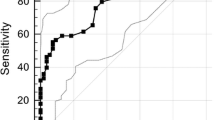Abstract
The purpose of this study was to evaluate the validity and the reliability of the European Portuguese version of the EAT-10 (P-EAT-10). This research was conducted in three phases: (i) cultural and linguistic adaptation; (ii) feasibility and reliability test; and (iii) validity tests. The final sample was formed by a cohort of 520 subjects. The P-EAT-10 index was compared for socio-demographic and clinic variables. It was also compared for both dysphagic and non-dysphagic groups as well as for the results of the 3Oz wst. Lastly, the P-EAT-10 scores were correlated with the EuroQol Group Portuguese EQ-5D index. The Cronbach’s α obtained for the P-EAT-10 scale was 0.952 and it remained excellent even if any item was deleted. The item-total and the intraclass correlation coefficients were very good. The P-EAT-10 mean of the non-dysphagic cohort was 0.56 and that of the dysphagic cohort was 14.26, the mean comparison between the 3Oz wst groups and the P-EAT-10 scores were significant. A significant higher perception of QoL was also found among the non-dysphagic subjects. P-EAT-10 is a valid and reliable measure that may be used to document dysphagia which makes it useful both for screening in clinical practice and in research.
Similar content being viewed by others
References
Nogueira D, Reis E. Swallowing disorders in nursing home residents: how can the problem be explained? Clin Interv Aging. 2013;8:221–7.
Ekberg O, Hamdy S, Woisard V, Wuttge-Hannig A, Ortega P. Social and psychological burden of dysphagia: its impact on diagnosis and treatment. Dysphagia. 2002;17(2):139–46. doi:10.1007/s00455-001-0113-5.
Steele CM, Greenwood C, Ens I, Robertson C, Seidman-Carlson R. Mealtime difficulties in a home for the aged: not just dysphagia. Dysphagia. 1997;12(1):43–50 discussion 1.
Wilkins T, Gillies RA, Thomas AM, Wagner PJ. The prevalence of dysphagia in primary care patients: a HamesNet Research Network study. J Am Board Fam Med. 2007;20(2):144–50. doi:10.3122/jabfm.2007.02.060045.
Bloem BR, Lagaay AM, van Beek W, Haan J, Roos RA, Wintzen AR. Prevalence of subjective dysphagia in community residents aged over 87. BMJ. 1990;300(6726):721–2.
Siebens H, Trupe E, Siebens A, Cook F, Anshen S, Hanauer R, et al. Correlates and consequences of eating dependency in institutionalized elderly. J Am Geriatr Soc. 1986;34(3):192–8.
Lindgren S, Janzon L. Prevalence of swallowing complaints and clinical findings among 50-79-year-old men and women in an urban population. Dysphagia. 1991;6(4):187–92.
Belafsky PC, Mouadeb DA, Rees CJ, Pryor JC, Postma GN, Allen J, et al. Validity and reliability of the Eating Assessment Tool (EAT-10). Ann Otol Rhinol Laryngol. 2008;117(12):919–24.
Leow LP, Huckabee ML, Anderson T, Beckert L. The impact of dysphagia on quality of life in ageing and Parkinson’s disease as measured by the swallowing quality of life (SWAL-QOL) questionnaire. Dysphagia. 2010;25(3):216–20. doi:10.1007/s00455-009-9245-9.
Eslick GD, Talley NJ. Dysphagia: epidemiology, risk factors and impact on quality of life–a population-based study. Aliment Pharmacol Ther. 2008;27(10):971–9. doi:10.1111/j.1365-2036.2008.03664.x.
Schindler A, Mozzanica F, Monzani A, Ceriani E, Atac M, Jukic-Peladic N, et al. Reliability and validity of the Italian Eating Assessment Tool. Ann Otol Rhinol Laryngol. 2013;122(11):717–24.
McHorney CA, Bricker DE, Robbins J, Kramer AE, Rosenbek JC, Chignell KA. The SWAL-QOL outcomes tool for oropharyngeal dysphagia in adults: II. Item reduction and preliminary scaling. Dysphagia. 2000;15(3):122–33.
Carlsson S, Ryden A, Rudberg I, Bove M, Bergquist H, Finizia C. Validation of the Swedish M. D. Anderson Dysphagia Inventory (MDADI) in patients with head and neck cancer and neurologic swallowing disturbances. Dysphagia. 2012;27(3):361–9. doi:10.1007/s00455-011-9375-8.
Manor Y, Giladi N, Cohen A, Fliss DM, Cohen JT. Validation of a swallowing disturbance questionnaire for detecting dysphagia in patients with Parkinson’s disease. Mov Disord. 2007;22(13):1917–21. doi:10.1002/mds.21625.
Dwivedi RC, St Rose S, Roe JW, Khan AS, Pepper C, Nutting CM, et al. Validation of the Sydney Swallow Questionnaire (SSQ) in a cohort of head and neck cancer patients. Oral Oncol. 2010;46(4):e10–4. doi:10.1016/j.oraloncology.2010.02.004.
Rofes L, Arreola V, Clave P. The volume-viscosity swallow test for clinical screening of dysphagia and aspiration. Nestle Nutr Inst Workshop Ser. 2012;72:33–42. doi:10.1159/000339979.
Rofes L, Arreola V, Mukherjee R, Clave P. Sensitivity and specificity of the Eating Assessment Tool and the Volume-Viscosity Swallow Test for clinical evaluation of oropharyngeal dysphagia. Neurogastroenterol Motil. 2014;26(9):1256–65. doi:10.1111/nmo.12382.
DePippo KL, Holas MA, Reding MJ. Validation of the 3-oz water swallow test for aspiration following stroke. Arch Neurol. 1992;49(12):1259–61.
Burgos R, Sarto B, Segurola H, Romagosa A, Puiggros C, Vazquez C, et al. Translation and validation of the Spanish version of the EAT-10 (Eating Assessment Tool-10) for the screening of dysphagia. Nutr Hosp. 2012;27(6):2048–54. doi:10.3305/nh.2012.27.6.6100.
Wild D, Grove A, Martin M, Eremenco S, McElroy S, Verjee-Lorenz A, et al. Principles of good practice for the translation and cultural adaptation process for patient-reported outcomes (PRO) measures: report of the ISPOR Task Force for translation and cultural adaptation. Value Health. 2005;8(2):94–104. doi:10.1111/j.1524-4733.2005.04054.x.
Morgado J, Rocha CS, Maruta C, Guerreiro M, Martins IP. Cut-off scores in MMSE: a moving target? Eur J Neurol. 2010;17(5):692–5. doi:10.1111/j.1468-1331.2009.02907.x.
Ferreira LN, Ferreira PL, Pereira LN, Oppe M. The valuation of the EQ-5D in Portugal. Quality Life Res. 2014;23(2):413–23. doi:10.1007/s11136-013-0448-z.
Ferreira LN, Ferreira PL, Pereira LN, Oppe M. EQ-5D Portuguese population norms. Qual Life Res. 2014;23(2):425–30. doi:10.1007/s11136-013-0488-4.
R. R, F. C, A. S. Introduction. In EQ-5D value sets – inventory, comparative review and user guide. 2007.
Conflict of interest
Authors declare no conflict of interest.
Author information
Authors and Affiliations
Corresponding author
Rights and permissions
About this article
Cite this article
Nogueira, D.S., Ferreira, P.L., Reis, E.A. et al. Measuring Outcomes for Dysphagia: Validity and Reliability of the European Portuguese Eating Assessment Tool (P-EAT-10). Dysphagia 30, 511–520 (2015). https://doi.org/10.1007/s00455-015-9630-5
Received:
Accepted:
Published:
Issue Date:
DOI: https://doi.org/10.1007/s00455-015-9630-5



